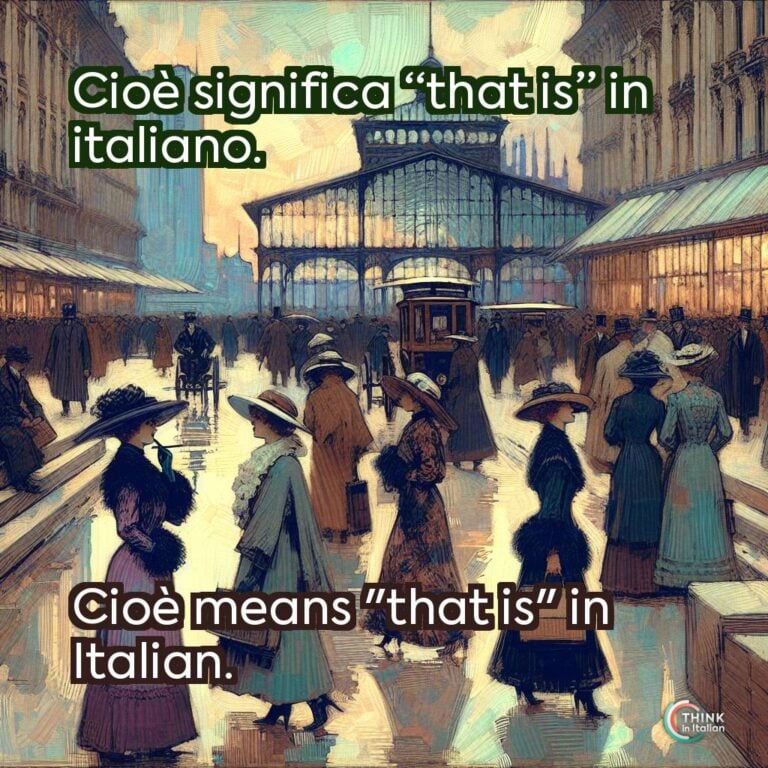“Cioè” in Italian
In Italian, the word cioè is one of the most frequently used expressions in both spoken and written language. It can be translated as “that is”, “I mean”, “in other words”, or “namely” and serves to clarify or further explain something just mentioned.
It helps to smooth conversations and offer additional information or clarification to ensure that what was said is fully understood.
Cioè is classified as either a conjunction or a discourse marker. In the first case it connects a sentence to the previous one, by introducing a rephrasing or clarification of what was just said.
In the second case, it allows to organize conversation and make speech more coherent. Compare the two examples below:
Il film era lungo, cioè, è durato più di tre ore.
The movie was long, that is, it lasted more than three hours.
Ho comprato un vestito, cioè, due vestiti perché non sapevo quale scegliere.
I bought a dress, I mean, two dresses because I couldn’t decide which one to choose.
In the first sentence it explains in more details why the speaker described the movie as “long”, while in the second one it is used to organize the speech and explain further what the speaker meant.
Linguistically speaking, cioè is composed of two smaller parts: the demonstrative pronoun ciò (“this” or “it”) and the third person singular of the present tense of the verb essere è (is). This is why cioè literally translates to “this is” or “that is”.
However, this word can be used in different ways depending on the context. Let me guide you through a detailed explanation.
How to use “Cioè”
Clarify a Statement
In conversation, cioè is frequently used to clarify something the speaker has just said, making the meaning more precise or adding extra information.
When you’re explaining something and want to ensure the listener understands exactly what you mean, you can use it to introduce further explanation or to simplify your statement.
Sono molto impegnato questa settimana, cioè, ho riunioni ogni giorno.
I’m very busy this week, that is, I have meetings every day.
Rephrase or Correct a Detail
Another common use of cioè is to rephrase or correct a detail in a statement. If you say something that may be unclear or you realize you need to correct something, it allows you to transition into the correction without interrupting the flow of conversation.
Vado a cena con Luigi, cioè, con Marco.
I’m going to dinner with Luigi, I mean, with Marco.
Soften or Mitigate a Previous Statement
Sometimes, after making a strong statement, you may feel the need to soften it or make it less absolute. Cioè is perfect for this, as it allows you to backtrack and qualify what you’ve just said, mitigating the impact of the original statement.
Il progetto è complicato, cioè, non impossibile, ma richiede molto lavoro.
The project is complicated, I mean, not impossible, but it requires a lot of work.
Filling Pauses While Thinking
In casual conversations, cioè serves as a filler word when the speaker needs a moment to think or organize their thoughts. It is one of the words that I unconsciously use the most, because it gives me time to pause without losing the listener’s attention.
It is very similar to “um” or “you know” in English.
Devo finire il rapporto per… cioè, devo fare prima il controllo sui dati.
I have to finish the report for… I mean, I have to first check the data.
Emphasizing key Points
Cioè often introduces critical information that the speaker wants to emphasize, drawing the listener’s attention to a specific point or making sure the listener understands what is being said.
It introduces a piece of information that the speaker wants to ensure doesn’t go unnoticed.
Questo è il miglior risultato possibile, cioè, non potevamo fare di meglio.
This is the best possible result, that is, we couldn’t have done any better.
Reinforcing Relationships Between Ideas
When presenting complex information, cioè allows you to reinforce the relationship between two connected ideas, to make sure that the listener understands how they relate to each other.
It is useful to signal that the second part of the statement further explains, supports, or elaborates on the first part.
La conferenza è stata un successo, cioè, c’erano più di 300 partecipanti.
The conference was a success, that is, there were more than 300 participants.




